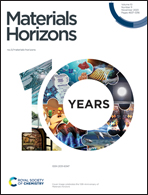Modulating piezoelectricity and mechanical strength via three-dimensional gradient structure for piezoelectric composites†
Abstract
Advanced flexible electronic devices make urgent demand for wearing comfort and data accuracy. Piezoelectric composites exhibit great potential, but mutually constrained mechanical strength and electrical output limit their further applications. Here, we design a gradient PMN-PT/PVDF nanocomposite via a non-equilibrium process integrated with a modified electrospinning and hot-pressing process to modulate the piezoelectric output and mechanical strength. The enhanced piezoelectric output together with the mechanical strength of the gradient structure are verified from both the experimental and simulation results. Ascribed to a unique three-dimensional gradient distribution, the prepared PMN-PT/PVDF nanocomposite exhibits an excellent mechanical strength (830 MPa) and piezoelectric performance (1.08 V), which are substantially higher than those of a randomly dispersed nanocomposite. The enhancement mechanism is revealed in terms of polarization, stress and crystallinity. These results of the gradient structure offer new opportunities to understand the structure-related mechanical and electrical behaviors of a nanocomposite, and support the design of a nanocomposite with overall performance.



 Please wait while we load your content...
Please wait while we load your content...